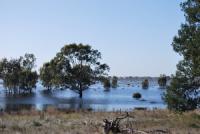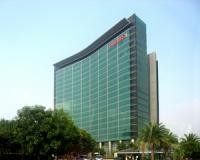-
With floods and droughts increasing, communities take a new look at storing water underground
Groundwater recharging – that is, actively moving water underground, a practice known as managed aquifer recharge (MAR) — is the latest wave in water security. There are about 1,200 managed aquifer recharge projects in 62 countries. MAR can be used to restore depleted aquifers, rehabilitate ecosystems and cleanse polluted water. But there are challenges as well.
-
-
It’s Alive! Creating innovative “living” bridge
Engineers have designed a unique living laboratory on a heavily traveled iconic bridge which could change the way infrastructure is viewed. The Memorial Bridge, which links Portsmouth, New Hampshire to Kittery, Maine, has been outfitted with data sensors that have transformed it into a self-diagnosing, self-reporting “smart” bridge that captures a range of information from the health of the span to the environment around it.
-
-
Dream of ideal “invisibility” cloaks for stress waves dashed
Whether Harry Potter’s invisibility cloak, which perfectly steers light waves around objects to make them invisible, will ever become reality remains to be seen, but perfecting a more crucial cloak is impossible, a new study says. It would have perfectly steered stress waves in the ground, like those emanating from a blast, around objects like buildings to make them “untouchable.”
-
-
Finding and fixing natural gas leaks quickly, economically
From production to consumption, natural gas leaks claim lives, damage the climate and waste money. Researchers are working on better ways to find and fix gas leaks quickly and inexpensively from one end of the system to the other.
-
-
Sensors may not make infrastructure safer
Simply driving down the road gives you a sense for the current state of our infrastructure: crumbling and in need of repair. New technology like sensors offers a way for inspectors to peer inside the systems almost continuously. But just placing a sensor on the side of a bridge doesn’t automatically lead to cost savings and a safer bridge.
-
-
Small towns, big flood waters
Climate change is bringing more water to people’s doorsteps, devastating communities. For some floodplain towns, survival comes down to sink, swim, or rise. Entire towns are moving to escape rising waters. But how do towns address these growing threats and still retain their sense of community? But how do you move an entire town? lood experts at UC Davis are visiting dozens of communities to find out. This is the story of two of those towns.
-
-
Rising seas threaten Australia’s major airports – and it may be happening faster than we think

Most major airports in Australia are located on reclaimed swamps, sitting only a few meters above the present-day sea level. And the risk of sea level rise from climate change poses a greater threat to our airports than we’re prepared for. Given the significant disruption cost and deep uncertainty associated with the timing of sea level rise, we must adopt a risk-based approach which considers extreme sea level rise scenarios as part of coastal infrastructure planning.
-
-
Rural areas more vulnerable to sea-level rise

Type “sea-level rise” in an internet search engine and almost all the resulting images will show flooded cities. But there is a growing recognition that sea-level rise will mostly impact rural land–much of it privately owned—where existing knowledge is insufficient o best inform private and public decisions on how to cope with the threat.
-
-
Can we prepare for climate impacts without creating financial chaos?
Likely sooner than we think, the destruction that warmer global temperatures are inflicting — through record floods, wildfires, droughts, and hurricanes — could physically overwhelm our ability to maintain many communities in their existing form. Communities face a tricky dilemma as climate changes: How to prepare for impacts without scaring away homeowners and investors and setting off a damaging economic spiral.
-
-
Google cuts Huawei access to Android software updates
Google said on Sunday it was rescinding Huawei’s license to use Google’s mobile phone operating system Android, and Google services such as Google maps and YouTube. The move will force the Chinese technology company to rely on an open-source version of the software. The move follows a presidential executive order prohibiting American companies from using telecommunications equipment made by “foreign adversaries” viewed as posing a threat to U.S. national security.
-
-
Why Huawei security concerns cannot be removed from U.S.-China relations

Huawei’s role in building new 5G networks has become one of the most controversial topics in current international relations. The U.S. is exercising direct diplomatic pressure to stop states from using the Chinese telecoms giant. The U.S. government regards Huawei as a clear and present danger to national security and argues that any ally opting for Huawei will compromise vital intelligence sharing among these countries in the future.
-
-
Cities can save lives, resources by using a vulnerability reduction scorecard
A new planning tool enables communities to effectively reduce their vulnerabilities to hazards across their network of plans – including transportation, parks, economic development, hazard mitigation, emergency management and comprehensive land use.
-
-
Bolstering cyber resilience
In December 2015, the first known successful cyberattack on a power grid was carried out in Ukraine, disrupting the electricity supply for hundreds of thousands of customers for several hours. Since then, concerns have grown across the globe about the potential public health, economic and security impacts of widespread power outages in heavily populated regions. Argonne partners with World Economic Forum in important cyber resilience effort.
-
-
Wandering Earth: rocket scientist explains how we could move our planet
In the Chinese science fiction film “The Wandering Earth,” recently released on Netflix, humanity attempts to change the Earth’s orbit using enormous thrusters in order to escape the expanding sun – and prevent a collision with Jupiter. The scenario may one day come true. How could we go about it and what are the engineering challenges?
-
-
The fundamental challenges of living with wildfire
Wildfires can have dramatic impacts on Western landscapes and communities, but human values determine whether the changes caused by fire are desired or dreaded. This is the simple - but often overlooked - message from a collaborative team of researchers.
-
- All
- Regional
- Water
- Biometrics
- Borders/Immig
- Business
- Cybersecurity
- Detection
- Disasters
- Government
- Infrastructure
- International
- Public health
- Public Safety
- Communication interoperabillity
- Emergency services
- Emergency medical services
- Fire
- First response
- IEDs
- Law Enforcement
- Law Enforcement Technology
- Military technology
- Nonlethal weapons
- Nuclear weapons
- Personal protection equipment
- Police
- Notification /alert systems
- Situational awareness
- Weapons systems
- Sci-Tech
- Sector Reports
- Surveillance
- Transportation
Advertising & Marketing: advertise@newswirepubs.com
Editorial: editor@newswirepubs.com
General: info@newswirepubs.com
2010-2011 © News Wire Publications, LLC News Wire Publications, LLC
220 Old Country Road | Suite 200 | Mineola | New York | 11501
Permissions and Policies
Editorial: editor@newswirepubs.com
General: info@newswirepubs.com
2010-2011 © News Wire Publications, LLC News Wire Publications, LLC
220 Old Country Road | Suite 200 | Mineola | New York | 11501
Permissions and Policies
